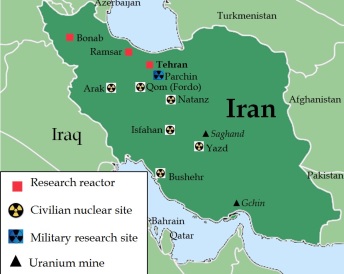 The following is a rundown of Iran’s key nuclear sites. Each will be a subject at diplomatic talks between the Islamic Republic and the world's six major powers.
The following is a rundown of Iran’s key nuclear sites. Each will be a subject at diplomatic talks between the Islamic Republic and the world's six major powers.
Bushehr Nuclear Facility
The Bushehr facility contains Iran’s first nuclear power plant. Its light-water reactor was loaded with nuclear fuel in August 2010. It has an operating capacity of 1,000 megawatts. Bushehr was originally launched in 1976 under contract with a German company, but after the 1979 revolution, Washington opposed it on the grounds that weapons grade plutonium could be extracted from the reactor’s waste, allowing Iran to construct nuclear weapons. Iran says the plant is for power-generation purposes only and will be subject to International Atomic Energy Agency (IAEA) safeguards.
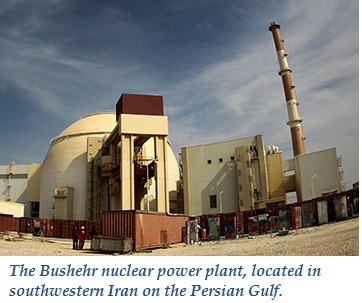 The theocracy halted construction of the Bushehr reactor after the 1979 revolution, and it was badly damaged during the 1980-1988 Iran-Iraq War. But Tehran decided to revive the project in 1990 to provide energy. The contract was awarded to Russia’s Rosatom Corp. To address international concerns, Moscow agreed to supply the enriched uranium fuel for the power plant and take back its plutonium-bearing spent fuel. In February 2005, Tehran and Moscow signed an agreement designed to ensure Iran could not divert enriched uranium for a weapons program. In September 2013, Russia transferred operational control of some key facilities to Iran.
The theocracy halted construction of the Bushehr reactor after the 1979 revolution, and it was badly damaged during the 1980-1988 Iran-Iraq War. But Tehran decided to revive the project in 1990 to provide energy. The contract was awarded to Russia’s Rosatom Corp. To address international concerns, Moscow agreed to supply the enriched uranium fuel for the power plant and take back its plutonium-bearing spent fuel. In February 2005, Tehran and Moscow signed an agreement designed to ensure Iran could not divert enriched uranium for a weapons program. In September 2013, Russia transferred operational control of some key facilities to Iran.Natanz Fuel Enrichment Facility
This fuel enrichment facility is at the heart of Iran’s dispute with the United Nations. The National Council of Resistance of Iran, an exiled opposition group, revealed the existence of the facility in 2002. It is located just outside the city of Natanz, approximately 130 miles south of Tehran.
The site consists of two facilities:
- An above-ground pilot fuel enrichment plant (PFEP)
- A larger, underground fuel enrichment plant with the capacity to hold up to 50,000 centrifuges (FEP).
 Activities at Natanz were suspended in 2004 following an agreement negotiated by Britain, France and Germany. But Iran restarted its uranium enrichment at the FEP after President Mahmoud Ahmadinejad’s election in 2005. The international community is concerned that Iran may use the enrichment technology at Natanz for nuclear weapons. These activities were proscribed by U.N. Security Council Resolution 1696 in 2006. Iran rejects the legality of these resolutions.
Activities at Natanz were suspended in 2004 following an agreement negotiated by Britain, France and Germany. But Iran restarted its uranium enrichment at the FEP after President Mahmoud Ahmadinejad’s election in 2005. The international community is concerned that Iran may use the enrichment technology at Natanz for nuclear weapons. These activities were proscribed by U.N. Security Council Resolution 1696 in 2006. Iran rejects the legality of these resolutions. Iran has not installed new centrifuges at either of the Natanz sites since the implementation of the November 2013 Joint Plan of Action. And enrichment of uranium above five percent is no longer taking place at Natanz, according to a February 2014 U.N. report. About 160 kg of uranium enriched to 20 percent still remains at the site but some of the stockpile is being downblended or converted to uranium oxide, which could not easily be used to fuel a nuclear weapon.
Isfahan Uranium Conversion Facility
The historic city of Isfahan is home to several nuclear-related sites, but the most significant facility is the Isfahan Uranium Conversion Plant. Isfahan also has a fuel fabrication laboratory, a uranium chemistry laboratory and a zirconium production plant. The conversion plant has been operational since 2006, and converts uranium yellowcake into uranium hexafluoride (UF6) for Iran's enrichment facilities. The facility can also produce uranium metal and oxides for fuel and other purposes.
Tehran Nuclear Research Center
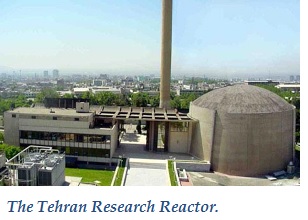 The Tehran Nuclear Research Center is a complex of several laboratories, including the Tehran Research Reactor (TRR). The TRR produces radioisotopes for medical and research purposes. The United States supplied Iran with the 5-megawatt light-water reactor in 1967; it was fueled with highly enriched uranium (around 90 percent). In 1987, Argentina concluded a deal with Iran to change the core of the reactor so it could operate on low-enriched uranium (20 percent).
The Tehran Nuclear Research Center is a complex of several laboratories, including the Tehran Research Reactor (TRR). The TRR produces radioisotopes for medical and research purposes. The United States supplied Iran with the 5-megawatt light-water reactor in 1967; it was fueled with highly enriched uranium (around 90 percent). In 1987, Argentina concluded a deal with Iran to change the core of the reactor so it could operate on low-enriched uranium (20 percent).Arak Heavy Water Plant and Reactor
The Arak nuclear facility includes a heavy water production plant, which has been operational since 2006, and a 40-megawatt heavy water reactor still under construction. The National Council of Resistance of Iran, an exiled opposition group, also revealed the existence of this facility in 2002.
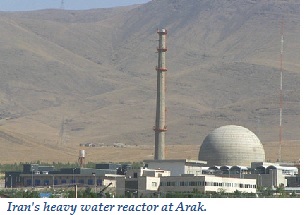 Heavy water production plants are not subject to traditional safeguards of the Nuclear Non-Proliferation Treaty, to which Iran is a signatory. Under the International Atomic Energy Agency’s Additional Protocol, Tehran would be subject to declarations and complementary access for IAEA inspectors. Since Iran has signed but not yet ratified the Additional Protocol, the IAEA uses satellite imagery to monitor the facility. Iran's heavy-water-related activities are also proscribed by U.N. Resolution 1696, which Tehran rejects.
Heavy water production plants are not subject to traditional safeguards of the Nuclear Non-Proliferation Treaty, to which Iran is a signatory. Under the International Atomic Energy Agency’s Additional Protocol, Tehran would be subject to declarations and complementary access for IAEA inspectors. Since Iran has signed but not yet ratified the Additional Protocol, the IAEA uses satellite imagery to monitor the facility. Iran's heavy-water-related activities are also proscribed by U.N. Resolution 1696, which Tehran rejects. In December 2013, Iran provided the IAEA with information and access to the plant. Approximately 100 tons of reactor-grade heavy water have been produced at Arak since 2006.
Qom Uranium Enrichment Facility (Fordo)
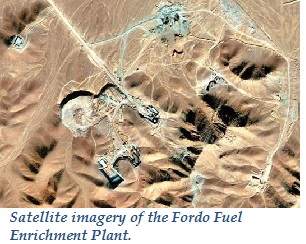 This secret uranium enrichment facility was made public in 2009 after the United States shared intelligence about it with allies, and Iran confirmed its existence. Construction of the uranium enrichment plant near the holy city of Qom began around 2006, but Tehran maintained that it was not required to report its existence under the safeguard obligations until six months before it became operational. The plant has a few installed centrifuges, but Iran stopped all work once the site was publicized. The facility is located on a mountain on what was reportedly a former Iranian Revolutionary Guards’ missile site.
This secret uranium enrichment facility was made public in 2009 after the United States shared intelligence about it with allies, and Iran confirmed its existence. Construction of the uranium enrichment plant near the holy city of Qom began around 2006, but Tehran maintained that it was not required to report its existence under the safeguard obligations until six months before it became operational. The plant has a few installed centrifuges, but Iran stopped all work once the site was publicized. The facility is located on a mountain on what was reportedly a former Iranian Revolutionary Guards’ missile site. The facility’s revelation prompted concern that Iran intended to construct a potential breakout facility where it could make weapon-grade uranium for a nuclear bomb. Iran told the IAEA that the plant was intended to enrich uranium only to 5 percent, which is not enough for a nuclear weapon. The plant is believed to have room for 3,000 centrifuges for uranium enrichment.
Parchin
Parchin is a military complex about 19 miles southeast of Tehran. The IAEA suspects Iran may have conducted experiments related to nuclear weapons production. U.N. inspectors visited the site twice in 2005 but did not find anything suspicious. But the IAEA later received additional evidence about alleged experiments. “We didn’t have enough information [back then],” IAEA chief Yukiya Amano said in 2012. “Extensive activities have taken place” at Parchin that have “seriously undermined” the IAEA’s ability to investigate possible military dimensions of Iran’s program, according to a February 2014 report.
Iran apparently undertook cleanup activities, according to satellite imagery analyzed by the Institute for Science and International Security. The IAEA noted that satellite imagery revealed “possible building material and debris” at Parchin in 2014.
Gchine Mine and Mill
The Gchine mine is located in southern Iran in Bandar Abbas. The associated mill is located at the same site. According to the IAEA, it began production in 2004 and has an estimated production capacity of 21 tons of uranium per year. The IAEA has questioned the mine’s ownership and relationship to Iran’s military. In January 2014, Iran provided the IAEA with managed access to the mine.
July 14 Update: Iran released the most detailed report to date explaining its practical needs for its nuclear program. It was posted on the quasi-official website NuclearEnergy.ir.
Photo credits: NuclearEnergy.ir, Natanz via Iranian President's Office and The New York Times
